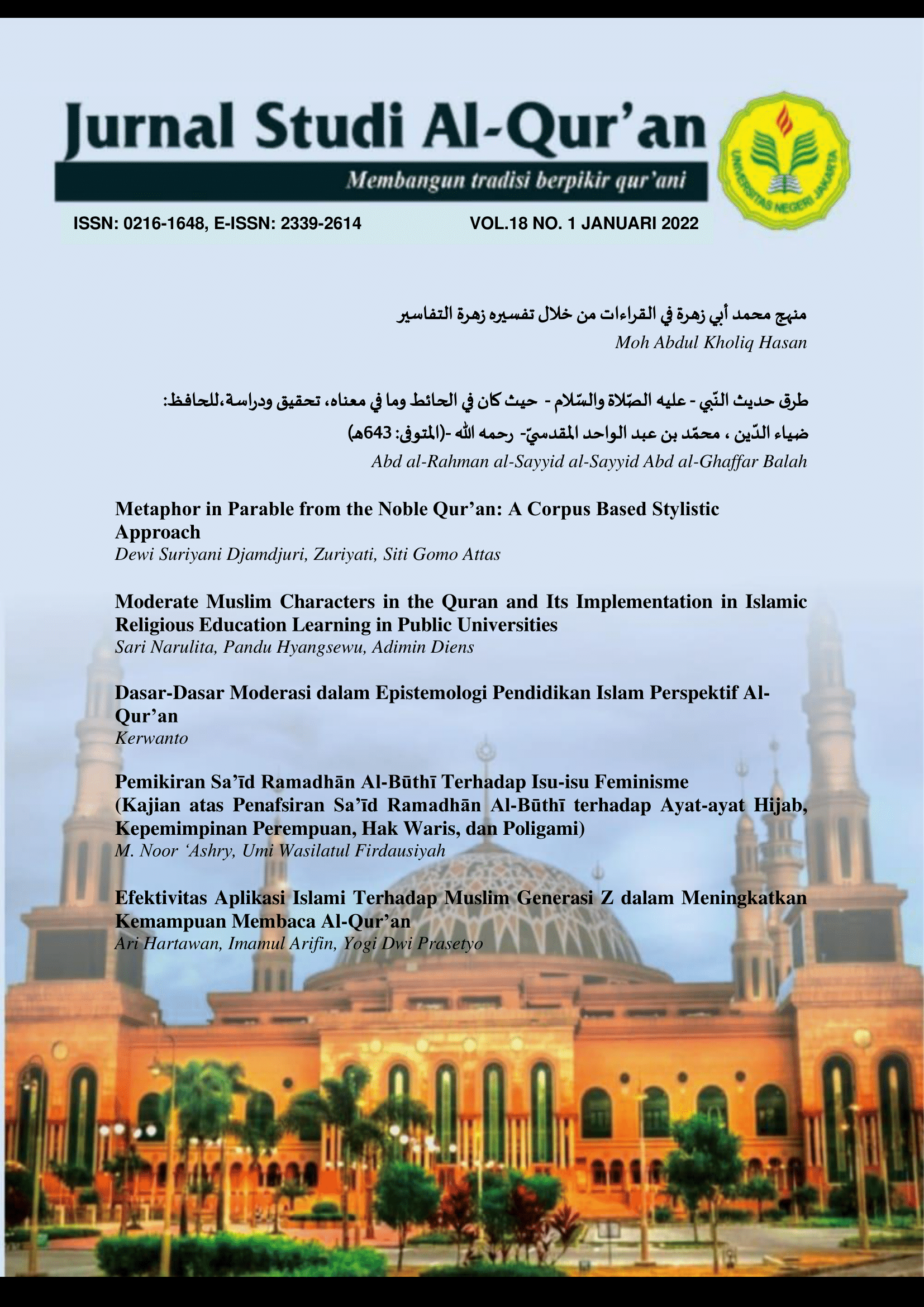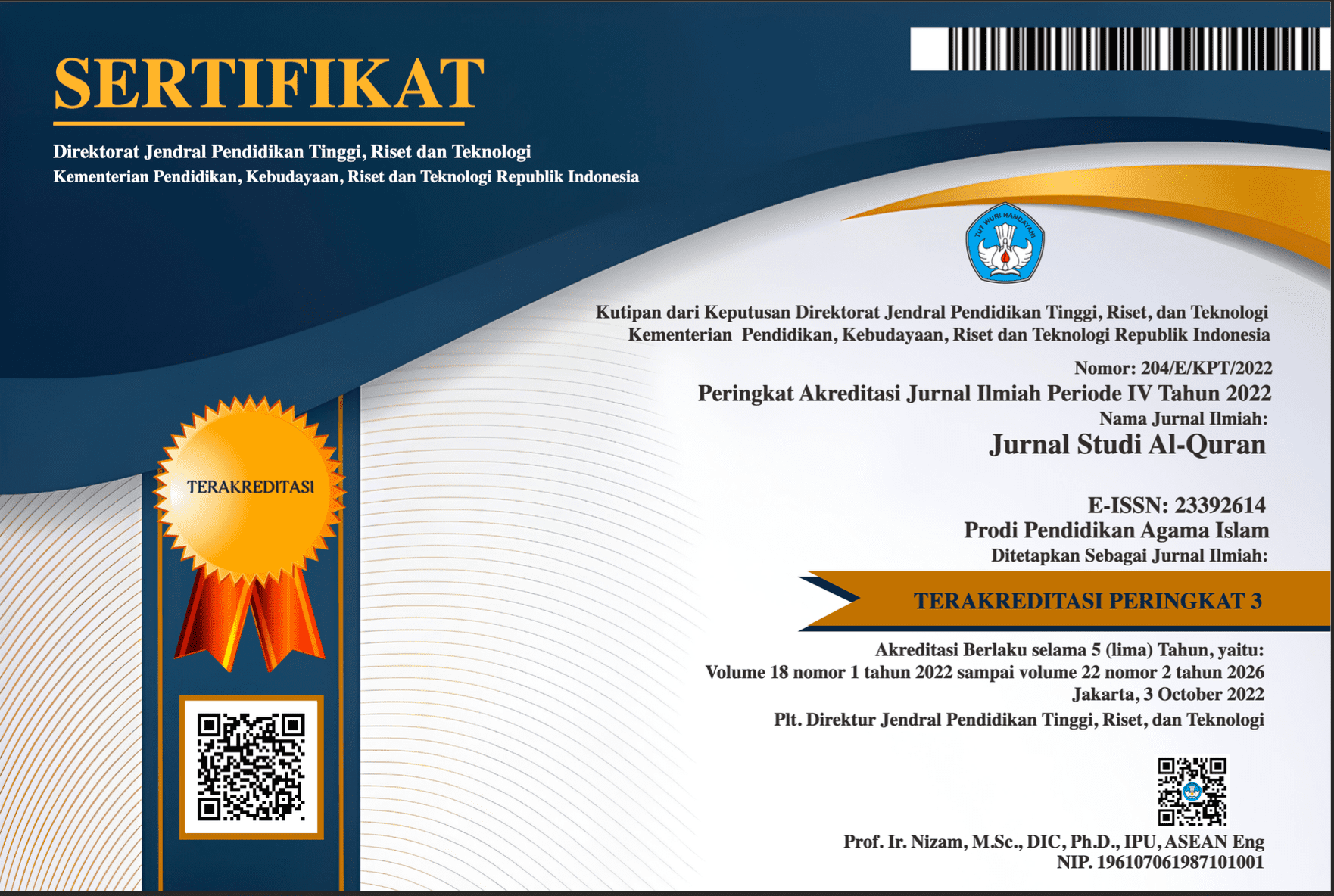Metaphor in Parable from the Noble Qur’an: A Corpus Based Stylistic Approach
DOI:
https://doi.org/10.21009/JSQ.018.1.03Keywords:
metaphor, parable, noble qur,an, corpus based stylisticAbstract
A compelling speech figure, a parable, or a metaphor in the Qur'an seeks to explain a crucial point by sticking in the mind and helping us absorb the message and firmly lodge it in our hearts. The stylistic method utilized in this study was a corpus-based stylistic method, which entails a contextual assessment of the term or pattern in issue. The information is based on passages from the Qur'anic corpus that have been translated into English. The stylistic corpus-based approach was used to investigate four different types of metaphor. They are standard, implied, visual, and extended metaphors, as evidenced by the findings. From the result finding it shows that there are 21 verses in the metaphor that are classified as standard metaphors, accounting for 61% of the metaphor. There are 5 verses, or 13%, of implied metaphor, 7 verses, or 18%, of visual metaphor, and 3 verses, or 8%, of extended metaphor. The metaphor that appeared the most frequently is a standard metaphor.
References
Al Hilali, M. M., & Khan, M. M. (1996). Translation of the Meanings of The Noble Qur’ar In The English Language. Madinah: King Fahd Complex for the Printing of the Holy Qur’an.
Ali, A. Y. (2012). The Meaning of the Glorious Qur'an Text, Translation & Commentry by: Abdullah Yusuf Ali. Retrieved from Islamic Buletin.org: https://www.pdfdrive.com/english-translation-of-the-noble-quran-by-yusuf-ali-e46652270.html
Al-Ma'ruf. (2017). Pengkajian Sastera Teori dan Aplikasi. CV. Jiwa Amarta.
Aulia, R. N. (2011). Menakar Kembali Pemikiran Feminisme Amina Wadud. Jurnal Studi Al-Qur’an , 7(1), 44 - 62
Bahri, S. (2020). The Different Types of Words Meaning in Minangkabau. Budapest nternational Research and Critics in Linguistics and Education (BirLE) Journal Volume 3, No 2 e-ISSN: 2655-1470 (Online), p-ISSN: 2655-2647 (Print) www.bircu-journal.com/index.php/birle, 695-705.
Bajwa, Z. A. (2017). Conceptual Metaphor Theory and Emotion Stylistics. An Analysis of Urdu Poems. Research Gate https://www.researchgate.net/publication/329374543, 1-16.
Blum, J. (2020, October 2). What is a Metaphor Definition and Examples of Metaphor in Literature. Retrieved from Master Class: https://www.masterclass.com/articles/what-is-a-metaphor#what-is-a-metaphor
Cook, G. (2003). Applied Linguistics. UK: Oxford University Press.
corpus.quran.com. (2020, October 26). Retrieved from corpus.quran.com: http://corpus.quran.com/translation.jsp?chapter=47&verse=15
Creswell, J. W., & Creswell, D. J. (2018). Reserach Design - Qualitative, Quantitative, aand Mixed Methods Approach (Fifth). Sage Publication, Inc.
Djamdjuri, D. S. (2014). The Ability of the Fourth Semester Students in Identifying the Adjectives and Adjectival Phrases from English Translation of Surah Al-Mulk. English Journal Vol. 15, No. 2 ISSN 1858-3490 http://ejournal.uika-bogor.ac.id/index.php/ENGLISH/article/view/258/255, 30.
Djamdjuri, D. S. (2016). The Effectiveness of Character Education in English Language Teaching Through the Islamic Teaching Materials. Bogor: Pascasarjana Universitas Ibn Khaldun.
Djamdjuri, D. S. (2020). Students' Interest on the Use of Islamic Teaching Materials in English Language Teaching. Proceedings of the 1st International Conference on Recent Innovations (ICRI 2018) (pp. 2093-2100). Portugal: SCITEPRESS – Science and Technology Publications, Lda.
Effendi, M. R. ., Khoerunnisa, I., & Syaprudin, D. (2021). Improving the Ability to Read the Qur’an Through Qiro’ati Method. Muttaqien Publishing, 1(1), 319–330.
Effendi, M. R. (2021). Teologi Islam; Potret Sejarah dan Perkembangan Mazhab KAlam. Literasi Nusantara.
Grey, W. (2015). Metaphor and meaning. Research Gate https://www.researchgate.net/publication/43488033, 1-10.
Gries, S. T. (2015). Quantitative designs and statistical techniques. In D. Biber, & R. Reppen, The Cambridge Handbook of English Corpus Linguistic (pp. 50-71). United Kingdom: Cambridge University Press.
Huges, C. (2003). Book Review: Disseminating Qualitative Research in Educational Settings. In Theory and Research in Education (Vol. 3, Issue 2). Open University Press. https://doi.org/10.1177/147787850500300209
Khoda, S. (2015). Pragmatics Analysis of The English Version of Education Method verses in The Book “Tafsir Pendidikan Islam”. (Unpublished). . Bogor, Jabar: English Education Program UIKA.
Lei, S. (2020). The Meaning of the Holy Quran, Abdullah Yusuf Ali. Retrieved from Academia.edu: https://www.academia.edu/41513103/The_Meaning_of_the_Holy_Quran_Abdullah_Yusuf_Ali
Marsin, M., Iskandar, I., & Attas, S. G. (2019). Metafora Cinta dalam Novel Balada Cinta Majenun Karya Geidurrahman El-Mishry. Jurnal KIBASP (Kajian Bahasa, Sastra Dan Pengajaran), 3(1), https://doi.org/https://doi.org/10.31539/kibasp.v3i1.913, 44-59.
Mills, G. E., & Gay, L. R. (2018). Educational Research Competencies for analysis and application. In Educational Research (Twelfth). Pearson.
Morteza, A. (2016). STUDY OF MENTAL IMAGERY IN THE PARABLE OF THE QURAN. The Turkish Online Journal of Design, Art and Communication DOI NO: 10.7456/1060NVSE/086, 2083-2811.
Muttaqien, A., Hadiyanto, A., & Mardhiah, I. (2016). Pengarusutamaan Islam Nusantara Melalui PAI dalam Perspektif Dosen PAI UNJ. Jurnal Studi Al-Qur’an , 12(1), 1 - 21
Pradopo, R. D. (1997). Ragam Bahasa Sastera. Humaniora, 4(1).
Qur'an.com. (2020, October 26). Retrieved from Qur'an.com: https://quran.com/
Semino, Elena, & Culpeper, J. (2002). Cognitive Stylistics. John Benjamins Publishing.
Siregar, K. I. (2021). Hermeneutika Hadis tentang “Hidupkan Saya Bersama Orang Miskin”(Analisis Kualitas dan Sharh Hadis). Hayula: Indonesian Journal of Multidisciplinary Islamic Studies, 5(1), 111-128.
Steen, G. (2016). Metaphor and Style. In P. Stockwell, & S. Whiteley, The Cambridge Book of Stylistic (pp. 316-328). UK: Camridge University Press.
Suparlan, Muliadi , M., & Masyudin. (2019). Stylistic Analysis of Edgar Allan Poe’s “The Bells”. Vol. 1, No. 4, August 2019. http://ojs.unimal.ac.id/index.php/ijevs. DOI: https://doi.org/10.29103/ijevs.v1i4.1605. International Journal for Educational and Vocational Studies, 273-281.
Tariq, M. (2018). Tariq, M. (2018). Style , stylistics and stylistic analysis : A re-evaluation of the modern-day rhetorics of literary discourse. 46-50.
Wellek, Rene, & Waren, A. (1989). Teori Kesusastraan (terjemahan). Jakarta: Gramedia.
Downloads
Published
How to Cite
Issue
Section
License
Authors who publish with this Journal agree to the following terms:
- Author retain copyright and grant the journal right of first publication with the work simultaneously licensed under a creative commons attribution licensethat allow others to share the work within an acknowledgement of the work’s authorship and initial publication of this journal.
- Authors are able to enter into separate, additional contractual arrangementfor the non-exclusive distribution of the journal’s published version of the work (e.g. acknowledgement of its initial publication in this journal).
- Authors are permitted and encouraged to post their work online(e.g. in institutional repositories or on their websites) prior to and during the submission process, as it can lead to productive exchanges, as well as earlier and greater citation of published works.
Users/public use of this website will be licensed to CC BY










